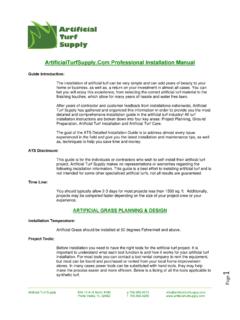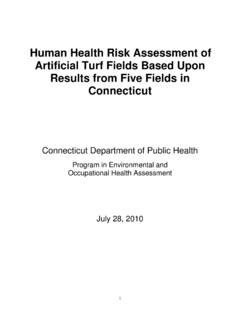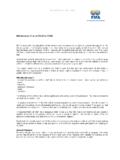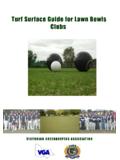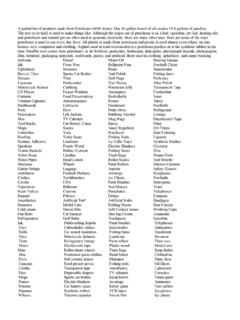Transcription of ArtificialTurfSupply.Com Professional Installation Manual
1 Artificial turf Supply 830-13 A1A North #160 p Ponte Vedra, FL 32082 f Page1 Professional Installation Manual Guide Introduction: The Installation of artificial turf can be very simple and can add years of beauty to your home or business, as well as, a return on your investment in almost all cases. You can bet you will enjoy this experience, from selecting the correct artificial turf material to the finishing touches, which allow for many years of hassle and water free lawn. After years of contractor and customer feedback from installations nationwide, Artificial turf Supply has gathered and organized this information in order to provide you the most detailed and comprehensive Installation guide in the artificial turf industry!
2 All turf Installation instructions are broken down into four key areas: Project Planning, Ground Preparation, Artificial turf Installation and Artificial turf Care. The goal of the ATS Detailed Installation Guide is to address almost every issue experienced in the field and give you the latest Installation and maintenance tips, as well as, techniques to help you save time and money. ATS Disclosure: This guide is for the individuals or contractors who wish to self-install their artificial turf project. Artificial turf Supply makes no representations or warranties regarding the following Installation information. This guide is a best effort to installing artificial turf and is not intended for some other specialized artificial turfs, not all results are guaranteed.
3 Time Line: You should typically allow 2-3 days for most projects less than 1500 sq. ft. Additionally, projects may be competed faster depending on the size of your project crew or your experience. ARTIFICIAL GRASS PLANNING & DESIGN Installation Temperature: Artificial Grass should be installed at 50 degrees Fahrenheit and above. Project Tools: Before Installation you need to have the right tools for the artificial turf project. It is important to understand what each tool function is and how it works for your artificial turf Installation . For most tools you can contact a tool rental company to rent the equipment, but most can be found and purchased or rented from your local home improvement stores. In many cases power tools can be substituted with hand tools, they may help make the process easier and more efficient.
4 Below is a listing of all the tools applicable to synthetic turf . Artificial turf Supply 830-13 A1A North #160 p Ponte Vedra, FL 32082 f Page2 List of Tools: (See Photo Appendix, Figure 1: Tools) Sod Cutter , Shovel, Hoe, Wheelbarrow, Measuring Tape, Spray Paint or Chalk Line, Landscape Rake, Broom, Fertilizer Spreader, Plate Compactor or Vibratory, Hand Roller or Plate Tamp, Trowel, Carpet Cutting Knives or Razor Knife, Trimming Shears, Roof Flashing, Seam Tape or other seaming solution, Glue, Carpet Kicker, Hammer, Staples, Nailer boards or 60 (D) Pole-Barn Nails. Design Size: In order to determine the best size and shape design for your project, you have to keep in mind that all the artificial turfs are 15 FEET WIDE and up to 100 ft.
5 Long. Artificial turf can be seamed together to create larger widths. The idea is to have the fewest amounts of seams as possible. Multiply the areas width and length based on 15 foot width rolls. This is how much turf you will need for your area. Your turf order should always be 15 foot wide by your determined lineal (Length) feet. Please make sure you allow for extra turf for any trimming and seaming. Please make sure that you measure at least twice and review your measurement with an Artificial turf Supply consultant. Additionally, the turf weighs about one half pound per square foot. To determine the weight of your artificial turf roll; divide the total square footage of each roll in half. For Example 750 sq. ft. divided in half is 375 Pounds. NOTE: Artificial turf comes on a carpet roll.
6 Bordering: For most borders you can use nailer board, bender boards or your imagination. Some contractors have folded the turf over onto itself but this is not recommended in most cases. Make sure to take note of the borders of where the turf will go and determine which curbing you will use and what edging techniques will be applied. If you are planning on installing any edging, curbing or borders, please install prior to cutting the turf in order to get a more precise measurement. If there is existing curbing or edging make sure that you measure perfectly in between the inside area of each of the borders. ATS Hot Tip: Some edging or bordering options that will enhance the appearance of your synthetic grass application are to add a nice frame around the turf : Curbing, decorative rock, mulch and treks boards are several ideas that will work nicely.
7 Vegetation: (See Photo Appendix, Figure 2: Vegetation) If your Installation is going around trees, bushes, or any utilities such as light poles and air conditioning units, you must mark around these areas in order to account for the turf edges. Typically you should allow a 6 radius area uncovered around the bases of any trees, bushes and structures. WARNING: Please check for any wells or electrical that may be located in project area. Current Irrigation: Check your area for irrigation heads. Once identified, be sure to cap them off or have them removed. Artificial turf Supply 830-13 A1A North #160 p Ponte Vedra, FL 32082 f Page3 turf Direction: Because the artificial turf is directional, you must make note of the fibers directions (grain).
8 Determine which direction you will roll out your turf and how the turf will be laid down and seamed. Most projects tend to face towards the viewer s perspective. If possible, you must always apply the turf with the fibers of the turf against the slope of your application area. Once you have made your decision on what direction your turf will go make sure to always run the fibers in the same direction. If you do not lay the turf , with the fibers going the same direction, the seams of your project will stick out and be too obvious. Artificial turf Selection: Now that we have our tools, design, bordering, turf direction and structures in mind we can begin the process of selection which turf you will use for your project. Typically for a residential and commercial application, Artificial turf Supply recommends a turf model from 40 ounces to 90 ounces per square yard of face weight.
9 These artificial grasses are extremely durable; dual thatched and will make for an easy Installation . Infill is always recommended to enhance the appearance, allow the artificial turf blades to stand up, emulate the feeling of soil, handle light to heavy traffic, add extra cushioning for an impact zone and increase the overall wear of your artificial turf system. GROUND PREPARATION Measuring & Outline: (See Photo Appendix, Figure 3: Measuring & Outline) Measure the width and length of each area by using irrigation flags or landscape stakes. Then use spray paint or chalk to mark your turf rolls. Note the direction you have decided to lay the turf when you did your planning. Removing Topsoil: (See Photo Appendix, Figure 4: Removing Topsoil) Utilizing a sod cutter, hoe or shovel to cut grass, sod or any other unwanted vegetation from your marked areas will make it easy to roll up and remove sod or any other topsoil that is currently in your project area.
10 Also remove any large rocks or roots that are unwanted. The typical depth of a sod cutter is set at 1-2 inches. However, some colder regions of the country may need to excavate up to 4 inches due to the need for more base material to address cold weather ground expansion and contraction. Do not forget to leave a 6" radius around trees, bushes or any shrubs. Rough Grading: (See Photo Appendix, Figure 5: Rough Grading) With a landscape rake, rough grade your turf application areas. Then use a garden hose to lightly water the areas and then compact the area with a plate compactor or a heavy drum roller. Keep making passes over the project area until you have ensured that your compaction is acceptable. 95% compaction is recommended. ATS Hot Tip: If your area has a high clay concentrate or is too moist and wet, then spread a small layer of crushed stone over the area before you do your compacting or use Artificial turf Supply 830-13 A1A North #160 p Ponte Vedra, FL 32082 f Page4 Geotextiles.
